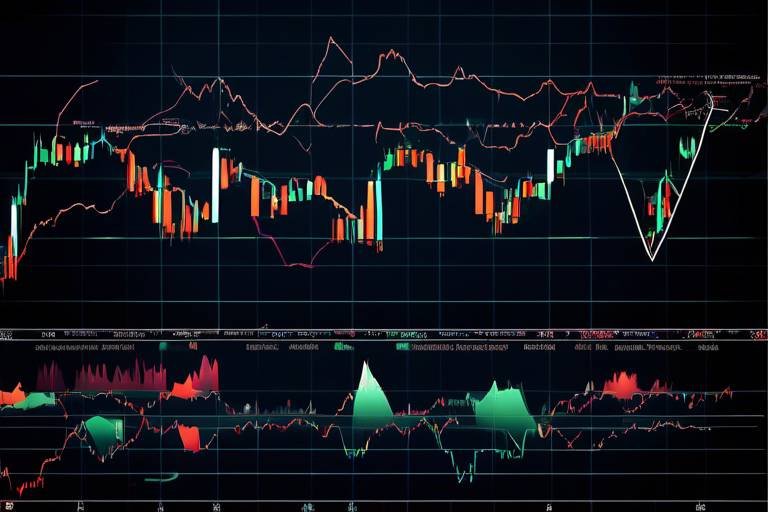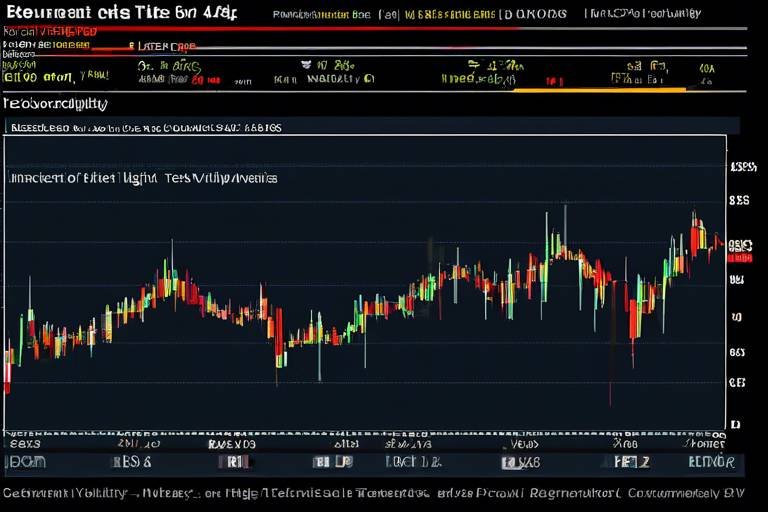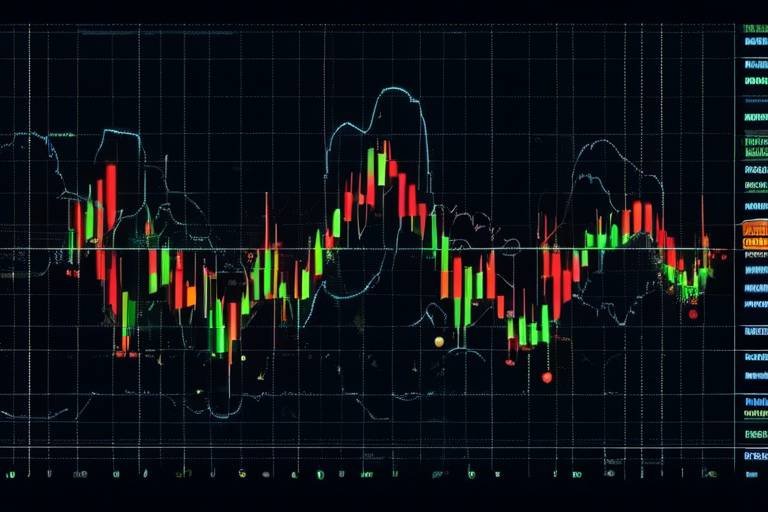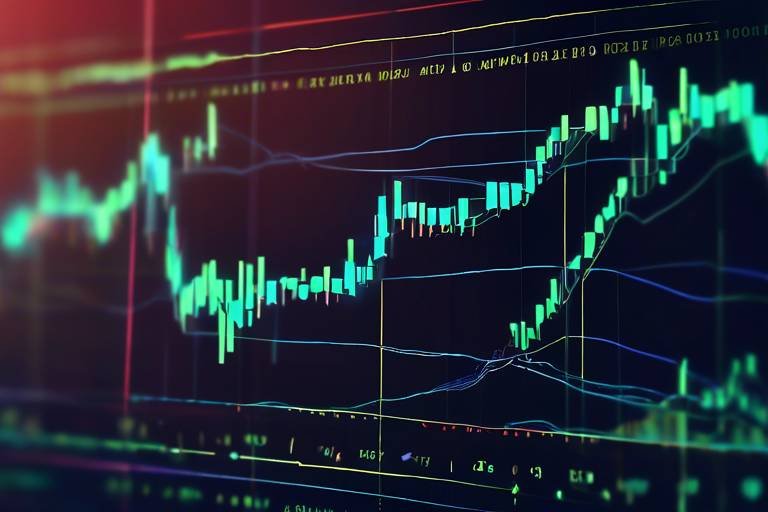How to Recognize Market Reversals with Technical Analysis
Understanding how to recognize market reversals is like having a treasure map in the world of trading. Imagine you're on a journey through a dense forest, and suddenly, you spot a sign that tells you to change direction. Market reversals are those signs—they indicate a significant shift in price movement, and knowing how to identify them can be the key to unlocking potential profits and minimizing losses.
Market reversals can happen at any time, and they often catch traders off guard. This is why it's crucial to arm yourself with the right tools and knowledge. The ability to recognize these patterns not only helps you navigate through the unpredictable waters of the market but also provides a strategic advantage. By using technical analysis, you can analyze price movements, identify key indicators, and make informed decisions that could lead to successful trades.
So, what exactly are market reversals? They signify a change in the prevailing trend—whether bullish or bearish. For instance, if the market has been on an upward trend, a reversal might indicate that it’s time to prepare for a downward movement. Conversely, a downward trend could signal a potential upward reversal. This dynamic nature of the market is what makes trading both exciting and challenging.
Traders rely on various strategies and indicators to spot these reversals. Technical analysis involves studying price charts and using tools such as moving averages, the Relative Strength Index (RSI), and the Moving Average Convergence Divergence (MACD). Each of these indicators offers unique insights into market behavior, helping traders to predict potential shifts in the market.
In the following sections, we will delve deeper into the key technical indicators, chart patterns, and volume analysis that can enhance your ability to recognize market reversals. With the right knowledge and tools, you can transform your trading strategy and navigate the market with confidence.
- What is a market reversal? A market reversal is a change in the direction of price movement, indicating a shift from an upward trend to a downward trend or vice versa.
- How can technical analysis help in identifying reversals? Technical analysis uses various indicators and chart patterns to analyze price movements, helping traders spot potential reversals before they happen.
- What are some common indicators used to identify market reversals? Common indicators include moving averages, the Relative Strength Index (RSI), and the Moving Average Convergence Divergence (MACD).
- Are market reversals easy to predict? While technical analysis can enhance your ability to predict market reversals, they are not always easy to identify due to market volatility and unexpected events.

Understanding Market Reversals
Market reversals are like the plot twists in a thrilling novel; they signal a dramatic change in the direction of price movement. Imagine you're on a roller coaster, climbing steadily to the top, only to find yourself plunging downwards in a heartbeat. That's exactly what happens in financial markets when reversals occur. Recognizing these patterns is crucial for traders who want to capitalize on potential profit opportunities and minimize losses during market fluctuations.
When we talk about market reversals, we're essentially discussing moments when the prevailing trend—whether bullish or bearish—loses momentum and shifts direction. This shift can happen for a variety of reasons, including changes in market sentiment, economic data releases, or even geopolitical events. Traders who can identify these reversals early are in a prime position to make informed decisions, optimizing their trading strategies for maximum benefit.
To truly grasp the concept of market reversals, we need to look at two key aspects: the psychology of traders and the technical indicators that signal these changes. The psychology of traders plays a significant role in market dynamics. For instance, when prices rise too quickly, traders may start to feel euphoric, leading to overbought conditions. Conversely, if prices fall sharply, fear sets in, creating oversold conditions. Understanding these emotional triggers can provide invaluable insights into potential reversals.
On the technical side, traders rely on various indicators to spot these reversals. Popular tools include moving averages, the Relative Strength Index (RSI), and various chart patterns. These indicators help traders analyze price movements and identify potential reversal points. For example, when a short-term moving average crosses below a long-term moving average, it may signal a bearish reversal. Similarly, an RSI reading above 70 could indicate that a market is overbought and due for a correction.
In summary, understanding market reversals is essential for any trader looking to navigate the complexities of financial markets. By combining insights from trader psychology and technical analysis, traders can better position themselves to anticipate changes in market direction, ultimately leading to more informed trading decisions and improved profitability.

Key Technical Indicators
When it comes to identifying market reversals, technical indicators are your best friends. These tools help traders make sense of the chaotic price movements and pinpoint potential turning points in the market. By leveraging these indicators, you can transform uncertainty into opportunity, enabling you to make more informed trading decisions. Let's dive into some of the most effective technical indicators that can assist you in spotting those crucial market reversals.
One of the most popular indicators is the Moving Average. This tool helps smooth out price data over a specified period, allowing traders to identify trends more clearly. There are two main types of moving averages: the Simple Moving Average (SMA) and the Exponential Moving Average (EMA). The SMA calculates the average price over a specific timeframe, which can be particularly useful for recognizing the overall trend. On the other hand, the EMA gives more weight to recent prices, making it more responsive to market changes. This responsiveness can be a game-changer when trying to detect potential reversals quickly.
Next up is the Relative Strength Index (RSI). This momentum oscillator measures the speed and change of price movements, helping traders gauge whether an asset is overbought or oversold. An RSI value above 70 typically indicates that an asset is overbought, while a value below 30 suggests it may be oversold. These extremes can signal potential market reversals, making the RSI a powerful tool in your trading arsenal. However, it's essential to remember that the RSI should be used in conjunction with other indicators for better accuracy.
The Moving Average Convergence Divergence (MACD) is another critical indicator worth mentioning. This tool combines moving averages to identify potential buy and sell signals. The MACD consists of two lines: the MACD line and the signal line. When the MACD line crosses above the signal line, it can indicate a bullish reversal, while a cross below may suggest a bearish reversal. Understanding these signals can significantly enhance your trading strategy.
To summarize the key indicators discussed, here’s a quick reference table:
| Indicator | Description | Use for Reversals |
|---|---|---|
| Moving Averages | Smooths out price data to identify trends | Look for crossover points |
| Relative Strength Index (RSI) | Measures speed and change of price movements | Identify overbought/oversold conditions |
| MACD | Combines moving averages for buy/sell signals | Watch for line crossovers |
By understanding these indicators and how they function, you can significantly improve your ability to recognize market reversals. Remember, the key is not to rely on a single indicator but to use them in combination to validate your trading decisions. This multi-faceted approach can provide you with a clearer picture of market dynamics, ultimately leading to more successful trades.
What are technical indicators?
Technical indicators are statistical tools used by traders to analyze price movements and forecast future price changes. They help in identifying trends, reversals, and market momentum.
How do I choose the right indicators for my trading strategy?
Choosing the right indicators depends on your trading style and objectives. It's often beneficial to experiment with different indicators to see which ones align best with your strategy.
Can I rely solely on technical indicators for trading decisions?
While technical indicators are valuable, relying solely on them can be risky. It's essential to consider other factors such as market news, economic indicators, and overall market sentiment.

Moving Averages
Moving averages are one of the most widely used tools in technical analysis, and for good reason! They help traders smooth out price data, making it easier to identify trends over time. Imagine you're trying to see the forest for the trees; moving averages act like a pair of binoculars that help you focus on the bigger picture. By analyzing the crossover points of short-term and long-term moving averages, traders can spot potential reversal signals in the market, which is crucial for making informed trading decisions.
There are two primary types of moving averages that traders often rely on: the Simple Moving Average (SMA) and the Exponential Moving Average (EMA). Each has its unique characteristics and applications, which we will explore further.
The Simple Moving Average (SMA) calculates the average price of an asset over a specified period. For example, a 10-day SMA adds up the closing prices of the last ten days and divides by ten. This method provides a straightforward view of the trend, but it can be slow to react to sudden price changes. Think of it like a large ship trying to change direction; it takes time to turn around. However, understanding how the SMA functions is vital for recognizing potential market reversals effectively, especially when combined with other indicators.
On the other hand, the Exponential Moving Average (EMA) is designed to give more weight to recent prices, making it more responsive to market changes. This characteristic allows traders to identify potential reversals more quickly compared to the SMA. If the SMA is like a large ship, the EMA is like a speedboat—quick to react and turn. Traders often look for crossovers between the EMA and the SMA to signal potential buy or sell opportunities. For instance, when the EMA crosses above the SMA, it may indicate a bullish reversal, while a crossover below can signal a bearish reversal.
To illustrate the differences between these two moving averages, let's take a look at the following table:
| Feature | Simple Moving Average (SMA) | Exponential Moving Average (EMA) |
|---|---|---|
| Calculation Method | Average of prices over a specific period | Weighted average that emphasizes recent prices |
| Responsiveness | Slower to react | Faster to react |
| Use Case | Identifying long-term trends | Spotting short-term price movements |
In conclusion, moving averages are essential tools for traders looking to identify market reversals. By understanding both the SMA and EMA, traders can better navigate the complexities of the market and make more informed decisions. Whether you're a seasoned trader or just starting, incorporating moving averages into your trading strategy can significantly enhance your ability to predict market movements and capitalize on profit opportunities.
- What is the best moving average for trading?
The best moving average often depends on your trading style. Short-term traders may prefer the EMA for its responsiveness, while long-term traders might find the SMA more suitable. - How do I use moving averages to identify reversals?
Look for crossover points between the SMA and EMA. A bullish reversal may occur when the EMA crosses above the SMA, while a bearish reversal may happen when it crosses below. - Can moving averages be used in all markets?
Yes, moving averages can be applied to various financial markets, including stocks, forex, and commodities.

Simple Moving Average (SMA)
The is one of the most widely used indicators in technical analysis, and for good reason. It’s like the compass of trading, guiding you through the often turbulent waters of market fluctuations. By calculating the average price of an asset over a specific period, the SMA helps traders identify trends and potential reversal points. Imagine you're trying to catch a wave while surfing; the SMA helps you gauge the current, allowing you to position yourself for the best ride.
To understand how the SMA works, let’s break it down. The SMA is calculated by taking the closing prices of an asset over a defined number of periods and dividing that sum by the total number of periods. For example, a 10-day SMA would add up the closing prices of the last ten days and divide by ten. This simple calculation smooths out price data, making it easier to spot trends without the noise of daily price fluctuations.
Here’s a quick look at how traders typically use the SMA:
- Trend Identification: When the price is above the SMA, it often indicates an uptrend, while a price below the SMA suggests a downtrend.
- Crossover Signals: Traders often look for crossover points where the price moves above or below the SMA. A bullish crossover occurs when the price crosses above the SMA, signaling a potential upward trend. Conversely, a bearish crossover happens when the price dips below the SMA, indicating a possible downward trend.
- Support and Resistance Levels: The SMA can act as a dynamic support or resistance level. Prices often bounce off the SMA, making it a crucial level to watch for potential reversals.
However, like any tool, the SMA is not foolproof. It can lag behind the current price action, especially in volatile markets. This lag can sometimes lead traders to miss out on early signals of reversals. Therefore, many traders combine the SMA with other indicators, such as the Exponential Moving Average (EMA) or the Relative Strength Index (RSI), to enhance their analysis and decision-making process.
In summary, the Simple Moving Average is a powerful tool in a trader's arsenal. By helping to identify trends and potential reversal points, it allows traders to make more informed decisions. Just remember, while the SMA can provide valuable insights, it should be used in conjunction with other indicators to maximize its effectiveness and minimize risks.
What is the main purpose of the Simple Moving Average?
The main purpose of the SMA is to smooth out price data over a specific period to help traders identify trends and potential reversal points in the market.
How do I calculate the Simple Moving Average?
To calculate the SMA, add the closing prices of an asset over a specific number of periods and then divide that sum by the total number of periods.
Can the SMA be used alone for trading decisions?
While the SMA is a useful tool, it’s best used in conjunction with other indicators to confirm signals and enhance trading decisions.
What are the limitations of the Simple Moving Average?
The SMA can lag behind the current price action, especially in volatile markets, which may result in missed opportunities for traders.

Exponential Moving Average (EMA)
The is a powerful tool in the arsenal of traders looking to identify potential market reversals. Unlike the Simple Moving Average (SMA), which treats all price points equally, the EMA gives greater weight to more recent prices. This responsiveness makes the EMA particularly valuable in fast-moving markets where conditions can change rapidly. By focusing on the latest data, the EMA helps traders stay ahead of the curve, allowing them to make informed decisions based on the most current market trends.
One of the key advantages of using the EMA is its ability to highlight shifts in momentum. For instance, when the EMA line crosses above the price line, it often signals that a bullish trend is gaining strength. Conversely, a cross below the price line might indicate a bearish reversal is in the works. This crossover point serves as a critical alert for traders, prompting them to reassess their positions and consider potential entry or exit points.
To illustrate the effectiveness of the EMA, let's take a look at a simple example. Imagine a trader monitoring a stock that has been on an upward trajectory. Suddenly, the price begins to stagnate, and the EMA starts to flatten out. This could be a sign that the bullish momentum is fading, and a reversal might be imminent. By being vigilant and interpreting the EMA correctly, traders can position themselves to capitalize on these shifts before the broader market catches on.
Moreover, traders often combine the EMA with other indicators for enhanced accuracy. For example, pairing the EMA with the Relative Strength Index (RSI) can provide a more comprehensive view of market conditions. If the EMA indicates a potential reversal while the RSI shows overbought or oversold conditions, traders can gain confidence in their predictions. This synergy between indicators is crucial for developing a robust trading strategy.
In summary, the Exponential Moving Average is not just a number; it's a dynamic tool that reflects the heartbeat of the market. By understanding how to interpret its signals, traders can better navigate the complexities of market reversals. Whether you're a seasoned trader or just starting, incorporating the EMA into your analysis can lead to more informed and strategic trading decisions.
- What is the main difference between EMA and SMA?
The main difference lies in their calculation; EMA gives more weight to recent prices, making it more responsive to market changes compared to the SMA, which averages all prices equally. - How can I use EMA to identify market reversals?
Look for crossover points where the EMA line crosses above or below the price line. These points often indicate potential reversals in market trends. - Is EMA suitable for all trading styles?
While EMA can be beneficial for day trading and swing trading due to its responsiveness, it may not be as effective for long-term investing strategies.

Relative Strength Index (RSI)
The Relative Strength Index, commonly known as RSI, is a powerful momentum oscillator that measures the speed and change of price movements. Developed by J. Welles Wilder, this indicator ranges from 0 to 100 and is typically used to identify overbought or oversold conditions in a market. But what does that really mean for traders? Well, when the RSI is above 70, it often indicates that an asset is overbought, suggesting that a price correction might be on the horizon. Conversely, an RSI below 30 indicates that an asset is oversold, which could signal a potential upward price reversal.
Understanding how to interpret RSI values is crucial for traders looking to optimize their strategies. For instance, if you notice that the RSI is approaching the overbought territory while the price continues to rise, it might be a good idea to prepare for a potential reversal. This is where the concept of divergence comes in. When the price makes a new high but the RSI does not, it could indicate weakening momentum, hinting at a possible trend reversal.
Another fascinating aspect of the RSI is its ability to generate trading signals. Traders often look for crossovers of the RSI line with specific levels, such as the 50 level, which can serve as a trend indicator. If the RSI crosses above 50, it may suggest a bullish trend, while a crossover below 50 could indicate a bearish trend. This simple yet effective strategy can help traders make informed decisions in real-time.
| RSI Level | Market Condition | Implication |
|---|---|---|
| 0 - 30 | Oversold | Potential upward reversal |
| 30 - 50 | Neutral | Market is indecisive |
| 50 - 70 | Bullish | Potential upward trend |
| 70 - 100 | Overbought | Potential downward reversal |
In conclusion, the RSI is not just a number; it’s a vital tool that can help traders navigate the often turbulent waters of market fluctuations. By understanding how to read it and applying its signals effectively, you can enhance your trading strategy and increase your chances of success. Remember, though, that no indicator is foolproof. Always combine the RSI with other indicators and analysis techniques for a more comprehensive view of the market.
- What is the best RSI setting for trading? While the default setting is 14 periods, some traders prefer shorter or longer periods depending on their trading style.
- Can RSI be used in all markets? Yes, RSI can be applied to any market, including stocks, forex, and cryptocurrencies.
- How do I confirm an RSI signal? It is advisable to use other indicators, such as moving averages or candlestick patterns, to confirm RSI signals before making a trade.

Chart Patterns to Watch
When it comes to identifying potential market reversals, chart patterns are your best friends. These visual formations on price charts can provide critical insights into the market's behavior and sentiment. Just like a detective examining clues at a crime scene, traders must analyze these patterns to anticipate future price movements. By keeping an eye on specific formations, traders can make informed decisions that could lead to profitable trades. So, what are the key patterns you should be on the lookout for? Let’s dive in!
One of the most well-known reversal patterns is the head and shoulders formation. This pattern typically appears at the end of an uptrend and signals a potential shift to a downtrend. Imagine a person with a head and two shoulders; the middle peak (the head) is higher than the two outer peaks (the shoulders). Recognizing this pattern early can be like catching a glimpse of a storm brewing on the horizon—it gives you time to prepare and adjust your trading strategy.
Another classic reversal pattern is the double top. This occurs when the price reaches a peak twice but fails to break above it, indicating a potential reversal from bullish to bearish. Think of it as a runner who tries to cross the finish line but stumbles back twice; the market is clearly struggling to maintain its momentum. On the flip side, the double bottom pattern signals a bullish reversal. It forms when the price hits a low point twice before bouncing back up, much like a spring that compresses and then shoots back into the air.
To further illustrate these patterns, consider the following table that summarizes their characteristics:
| Chart Pattern | Formation | Indicates |
|---|---|---|
| Head and Shoulders | Three peaks: left shoulder, head, right shoulder | Potential bearish reversal |
| Double Top | Two peaks at the same price level | Potential bearish reversal |
| Double Bottom | Two troughs at the same price level | Potential bullish reversal |
Understanding these patterns is essential, but it’s equally important to consider the context in which they appear. For instance, a double top pattern emerging after a significant uptrend can be a stronger signal than one that forms in a sideways market. Likewise, volume plays a critical role here; a double top accompanied by declining volume can indicate weakness in the bullish trend, making a reversal more likely.
In conclusion, by familiarizing yourself with these chart patterns—head and shoulders, double tops, and double bottoms—you can enhance your ability to spot potential market reversals. Just remember, the market is like a puzzle, and each pattern is a piece that helps you see the bigger picture. So, keep your eyes peeled and your charts updated; the next big opportunity might just be around the corner!
Q: How reliable are chart patterns for predicting market reversals?
A: While chart patterns can provide valuable insights, they are not foolproof. It's crucial to combine them with other technical indicators and market analysis for better accuracy.
Q: Can I use chart patterns on any timeframe?
A: Yes, chart patterns can be applied to any timeframe, but their reliability may vary. Patterns on longer timeframes tend to be more significant than those on shorter timeframes.
Q: How can I practice identifying chart patterns?
A: You can practice by analyzing historical price charts and using demo trading accounts to apply your knowledge without risking real money.

Head and Shoulders
The head and shoulders pattern is one of the most recognized and powerful indicators of market reversals in technical analysis. It typically appears at the end of an uptrend and signals a potential shift to a downtrend. Imagine you're climbing a mountain, and just as you reach the peak (the head), you notice the landscape changing. This pattern consists of three peaks: the left shoulder, the head, and the right shoulder. Each of these peaks represents a price point, and their arrangement tells a story of market sentiment.
To visualize this, picture the following:
| Peak | Price Action |
|---|---|
| Left Shoulder | Price rises to a peak and then declines. |
| Head | Price rises to a higher peak and then declines again. |
| Right Shoulder | Price rises again but fails to exceed the head's peak before declining. |
What makes the head and shoulders pattern particularly valuable is its reliability. When traders spot this formation, they often prepare for a bearish trend. The confirmation line, also known as the neckline, is drawn by connecting the lows of the left and right shoulders. A break below this line serves as a strong signal that the market is reversing. It’s like a red flag waving in the wind, indicating that a storm might be brewing.
However, not all head and shoulders formations lead to a reversal. Traders must also consider other factors such as volume and market context. For instance, if the price breaks the neckline with high volume, it adds credibility to the reversal signal. Conversely, if the break occurs with low volume, it might just be a temporary fluctuation rather than a full-blown trend reversal.
In summary, recognizing the head and shoulders pattern can empower traders to make informed decisions. By understanding the market's psychology behind this formation, traders can better position themselves for potential profits while minimizing risks. So, the next time you see a peak forming, ask yourself: Is this the head and shoulders pattern signaling a change in direction?
- What does a head and shoulders pattern indicate? It indicates a potential reversal from a bullish trend to a bearish trend.
- How can I identify the head and shoulders pattern? Look for three peaks: a left shoulder, a higher head, and a right shoulder, with a neckline connecting the lows.
- Is the head and shoulders pattern always reliable? While it's a strong indicator, it's essential to confirm with other factors like volume and overall market conditions.

Double Tops and Bottoms
Double tops and bottoms are some of the most widely recognized reversal patterns in technical analysis, and for good reason! These patterns can provide traders with crucial insights into potential shifts in market sentiment. A double top typically forms after a strong bullish trend and signals a shift to bearish sentiment, while a double bottom emerges after a bearish trend, indicating a potential move to bullish territory.
To visualize this, imagine a mountain (the double top) where the price climbs to a peak, dips slightly, and then climbs back to a similar peak before falling again. Conversely, picture a valley (the double bottom) where the price drops, rises slightly, and then drops again to a similar low before bouncing back up. Recognizing these formations can be a game-changer for traders looking to optimize their strategies.
Here’s how to identify these patterns:
- Double Top: This pattern typically consists of two peaks at roughly the same price level, separated by a trough. It often indicates that the market is unable to sustain higher prices, leading to a potential price decline.
- Double Bottom: This pattern features two troughs at approximately the same price level, separated by a peak. It suggests that the market is finding support at this level and may be ready to reverse to the upside.
Timing is everything when it comes to acting on these patterns. Traders often look for confirmation through volume; for instance, a double top is more reliable if accompanied by an increase in volume during the decline after the second peak. Similarly, a double bottom is considered stronger if there’s a rise in volume as the price starts to climb after the second trough.
It's also essential to set appropriate stop-loss orders when trading these patterns. For a double top, placing a stop-loss just above the second peak can help protect against unexpected price movements. In contrast, for a double bottom, a stop-loss just below the second trough can safeguard your investment. This way, you can manage risk while still capitalizing on potential profits.
In summary, double tops and bottoms are not just patterns; they are signals that can lead to significant trading opportunities. By honing your skills in identifying these formations and understanding their implications, you can enhance your ability to navigate the often turbulent waters of the financial markets.
Q1: How can I confirm a double top or bottom pattern?
A1: Confirmation often comes from an increase in volume during the price movement after the pattern is formed. For double tops, look for higher volume on the decline, and for double bottoms, higher volume on the rise.
Q2: Are double tops and bottoms always reliable?
A2: While they are useful indicators, no pattern is foolproof. It's essential to consider other factors, such as market conditions and additional technical indicators, before making trading decisions.
Q3: What should I do if I spot a double top or bottom?
A3: If you identify a double top, consider selling or shorting the asset. If you spot a double bottom, it may be a good time to buy. Always use stop-loss orders to manage your risk.

Volume Analysis
When it comes to trading, volume analysis is like the heartbeat of the market. It gives traders insights into the strength or weakness of a price movement, and understanding this can be a game-changer. Think of volume as the crowd at a concert; if the crowd is roaring and energetic, you know the show is a hit. Conversely, if the audience is sparse and quiet, you can expect the performance to be lackluster. Similarly, high trading volume often indicates strong interest in a particular asset, while low volume can signal a lack of conviction in price movements.
One of the most critical aspects of volume analysis is identifying volume spikes. A sudden surge in trading volume often precedes significant price movements, serving as a warning signal that something is about to happen. For instance, if a stock that typically sees 100,000 shares traded daily suddenly experiences a spike to 500,000 shares, it suggests that traders are reacting to new information or sentiment. This can be an opportunity to jump in or out of a trade before the price moves dramatically.
Moreover, understanding volume divergence is equally essential. This occurs when price movements and volume trends do not align. For example, if a stock's price is rising, but the volume is decreasing, it could indicate that the upward trend lacks strength and might reverse soon. Conversely, if the price is falling while volume is increasing, this could signal a strong selling pressure, hinting at a potential reversal. Recognizing these subtle cues can significantly enhance a trader's ability to navigate the turbulent waters of the market.
To sum it up, volume analysis is not just a secondary tool; it's a vital component of your trading strategy. By paying attention to volume spikes and divergences, traders can gain valuable insights into market sentiment and make more informed decisions. Remember, in the world of trading, knowledge is power, and understanding volume can give you the edge you need to succeed.
- What is volume analysis in trading?
Volume analysis involves examining the number of shares or contracts traded in a given period to identify the strength of price movements and potential market reversals. - How do I use volume spikes to my advantage?
Volume spikes can indicate upcoming price movements. If you notice a significant increase in volume, it may be wise to investigate the reasons behind it and consider adjusting your trading strategy accordingly. - What does volume divergence mean?
Volume divergence occurs when the price of an asset moves in one direction while the volume moves in the opposite direction, suggesting a potential reversal in the price trend.

Volume Spikes
When it comes to trading, understanding can be your secret weapon. A volume spike occurs when there is a sudden increase in the number of shares or contracts traded in a specific time frame. This surge often precedes significant price movements, making it a crucial indicator for traders looking to spot potential market reversals. Imagine you’re at a concert, and the crowd suddenly erupts in cheers; that’s akin to a volume spike in the trading world, signaling that something important is happening.
Recognizing volume spikes can help you make informed decisions. For instance, if you notice a considerable increase in volume while the price is moving upward, it might indicate strong buying pressure, suggesting that the trend could continue. Conversely, if volume spikes occur during a price drop, it might signal that sellers are gaining control, hinting at an impending reversal. To illustrate this, let’s take a look at the following table:
| Scenario | Volume Behavior | Potential Implication |
|---|---|---|
| Price Increase + Volume Spike | High Volume | Strong Buying Pressure |
| Price Decrease + Volume Spike | High Volume | Strong Selling Pressure |
| Price Increase + Low Volume | Low Volume | Weak Trend |
| Price Decrease + Low Volume | Low Volume | Weak Trend |
As you can see, the relationship between price movements and volume is pivotal. But don’t just rely on volume spikes alone; consider them in conjunction with other indicators and patterns to enhance your trading strategy. For example, if you spot a volume spike alongside a bullish candlestick pattern, it could strengthen your conviction that a reversal is imminent.
Additionally, it’s essential to keep an eye on the context of these volume spikes. Are they occurring during significant news announcements or market events? Such factors can amplify the effects of volume spikes, leading to more pronounced price reversals. In essence, volume spikes serve as a loudspeaker in the trading arena, amplifying the underlying sentiment of the market.
In summary, mastering the art of recognizing volume spikes can significantly enhance your trading prowess. By paying attention to these sudden bursts of activity, you can better predict potential market reversals and make more informed trading decisions. So, the next time you’re analyzing a stock or currency pair, don’t forget to tune into the volume; it might just reveal the hidden signals that can lead you to success.
- What is a volume spike? A volume spike is a sudden increase in trading volume, often indicating significant price movements.
- How can I identify a volume spike? Look for unusual increases in volume compared to the average volume over a specific time frame.
- What does a volume spike indicate? It can indicate strong buying or selling pressure, potentially signaling a market reversal.
- Should I rely solely on volume spikes for trading decisions? No, it's best to use volume spikes in conjunction with other technical indicators and market analysis.

Volume Divergence
Volume divergence is a powerful concept in technical analysis that traders often overlook. It occurs when the price of an asset is moving in one direction while the volume is moving in the opposite direction. This disconnection can signal a potential market reversal, making it essential for traders to recognize and understand its implications. Imagine a car revving its engine while the brakes are applied—this disconnect can indicate that something is off and a change is imminent.
To grasp volume divergence fully, let's break it down into two main types: positive divergence and negative divergence. Positive divergence happens when prices are making lower lows, but the volume is increasing, suggesting that the selling pressure may be weakening. Conversely, negative divergence occurs when prices are making higher highs, but the volume is decreasing, indicating that the buying momentum might be fading. Recognizing these patterns can provide traders with valuable insights into potential market shifts.
Here's a quick overview of how to identify volume divergence:
- Look for price action: Monitor the price movement of the asset. Are there lower lows or higher highs?
- Analyze volume trends: Check the volume indicators to see if they contradict the price action.
- Confirm with other indicators: Use additional tools like RSI or MACD to validate your findings.
Understanding volume divergence can significantly enhance your trading strategy. It acts as a red flag, alerting you to potential reversals that might not be apparent just by looking at price charts alone. By incorporating volume analysis into your trading toolkit, you can make more informed decisions and potentially increase your profitability.
What is volume divergence?
Volume divergence occurs when the price of an asset moves in one direction while the trading volume moves in the opposite direction, indicating a potential market reversal.
How can I identify volume divergence?
To identify volume divergence, look for discrepancies between price action (lower lows or higher highs) and volume trends (increasing or decreasing volume). Use additional indicators for confirmation.
Why is volume divergence important?
Volume divergence is crucial because it helps traders anticipate potential market reversals, allowing them to adjust their strategies accordingly and minimize losses.
Frequently Asked Questions
- What are market reversals?
Market reversals are significant changes in the direction of price movement. They can signal a shift from a bullish trend to a bearish one or vice versa. Recognizing these patterns is essential for traders seeking to maximize their profit opportunities and minimize potential losses.
- How can I identify market reversals using technical analysis?
Traders can identify market reversals through various technical indicators such as moving averages, RSI, and MACD. By analyzing these indicators and their signals, traders can make informed decisions about potential market shifts.
- What is the difference between Simple Moving Average (SMA) and Exponential Moving Average (EMA)?
The Simple Moving Average (SMA) calculates the average price over a specific period, providing a smooth trend line. In contrast, the Exponential Moving Average (EMA) gives more weight to recent prices, making it more responsive to market changes. This responsiveness can help traders spot potential reversals more quickly.
- What does the Relative Strength Index (RSI) indicate?
The Relative Strength Index (RSI) measures the speed and change of price movements, helping traders identify overbought or oversold conditions. An RSI value above 70 typically indicates overbought conditions, while a value below 30 suggests oversold conditions, signaling potential market reversals.
- What chart patterns should I look for to identify reversals?
Key chart patterns that signal potential market reversals include head and shoulders, double tops, and double bottoms. Recognizing these formations can provide valuable insights into impending market shifts, allowing traders to adjust their strategies accordingly.
- How does volume analysis contribute to identifying market reversals?
Volume analysis is crucial in confirming market reversals. A sudden increase in trading volume often precedes significant price movements, while volume divergence can indicate a lack of strength in price movements, providing additional clues about potential reversals.
- What are volume spikes, and how do they relate to market reversals?
Volume spikes refer to a sudden increase in trading volume, which can signal impending price movements. Recognizing these spikes can help traders identify potential market reversals more accurately, as they often indicate heightened interest or activity in a particular asset.
- What is volume divergence, and why is it important?
Volume divergence occurs when price movements and volume trends do not align, which can indicate a weakening trend. Understanding volume divergence can provide traders with insights into potential market reversals, helping them make more informed trading decisions.



















